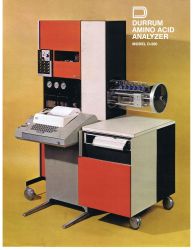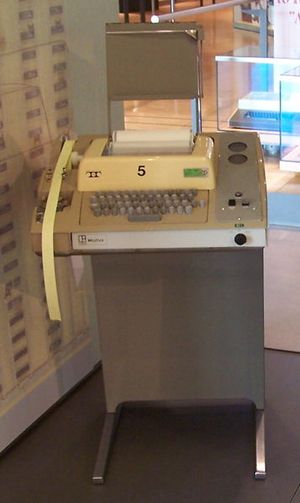Durrum D-500
Use {{pm}} instead of {{pmheader}}
The D-500 Amino acid Analyzer
How it worked
The D-500 Amino Acid Analyzer was designed and built by Durrum Instruments. At that time, Durrum was located on Fabian Way, Palo Alto, California, which was the spawning point of many high-tech companies.
The analysis process began with a technician processing a sample into liquid form. About one-half a drop of sample is injected into a "holder" (filled with super fine resin beads made by Diamond-Shamrock) which was manually inserted into the analyzer.
The brains of the D-500 (a PDP-8 computer), controlled an electrical pump with a piston made of synthetic ruby to control a very precise flow of hydraulic fluid to drive a "mechanical ram" assembly. This ram assembly had eight pistons/syringes (four on each side), each filled with a different pH liquid buffer. These buffers were then washed across the sample holder and into another resin bead filled tube which had an inside diameter of about the diameter of a human hair.
Again, the PDP-8 was used to control the temperature of the separation tube. Since different amino-acids have different gram-molecular weights and sizes, they were washed through the separation tube; much like different sized objects move through beach sand at different speeds. At the bottom end of the separation tube, the effluent was mixed with ninhydrin, a chemical that changes color in the presence of ammonia, a component part of amino-acids.
A colorimeter passes a precisely controlled wavelength light through a series of lenses and the effluent to a light sensor on the other side of the fluid stream. The output of the colorimeter was then fed back to the computer for processing. The computer would, besides sending a printout to the teletype, also drive a pen and ink recorder to create a visual graph.
Once the run (the time the sample was being analyzed, determined by the operator) the computer would then determine the time and the percentage of each amino-acid present as they exited the separation tube.
As I said earlier, different molecules pass through the resin tube at various speeds, so by graphing the output of the colorimeter against time, it can be determined which amino-acid is present. The amount of light passing through the colorimeter determined the "percentage of change from the base line".
"The Magic"
Now here is where the "Magic" happens. The results of the analysis can be affected by:
- the volume of buffer flow (which changes the separation times between various amino-acids - controlled by the speed of the ruby-piston pump) Flow is also affected by the inside diameter of the tube; the size of the resin beads, and how tightly they are packed inside the tube. Each separation tube had to be installed by a factory trained tech, and days of testing and running baselines would begin all over again to recalibrate the analyzer.
- the size of the sample (controlled by the lab assistant preparing the sample)
- the temperature of the resin-bead tube (too high, the sample will be destroyed, too low the sample will not separated)
- the volume of ninhydrin being added to the effluent
- the pH of the buffer being used to "wash" the sample through the resin-beads
- The D-500 analyzer installed at Rockefeller University, NYC "died". When I arrived to "repair" it, I discovered that the dual-doctorate lab assistant had prepared (but failed to verify the pH) of the new set of buffers. It's always nice to catch "an expert" in an error.)
- the original analyzer design began with calcium citrate washing buffer.
- When Lamont-Dougherty Labs began testing amino acids from shells, residue from the samples, when heated, became calcium carbonate (chalk) which "clogged up the works". By changing to lithium citrate buffers, the problem was eliminated.
It was up to the person (or team) installing the analyzer, to run it unceasingly for days to provide base-line computations. These base-lines were used for future comparisons to insure the machine was still operating correctly, and to provide confidence in the calibration of future runs.
- Notes -
- This was all done on a computer with 4k of memory
- Eldex is still making precision pumps (These days, they are located in Napa, California)
What it did
The D-500 Amino-Acid analyzer was instrumental in
- developing a blood test for diagnosis of PKU (Phenylketonuria) in new born infants
- determining genus and family of prehistoric shell fish by studying the genetic makeup of samples brought up from the ocean floor by the Glomar Explorer and Glomar Challenger of Howard Hughes fame.
- Study of deamino-carba analogs in Vasotocin.
- Molecular Cloning and Expression in Different Microbes of the DNA Encoding Pseudomonas putida to improve the rate of benzylpenicillin biosynthesis.
- Study of the Substrate of Avian Myeloblastosis Virus Proteinase and Lentiviral Proteinases
- Mammalian growth factors, and in particular to heparin-binding growth factors
The PDP-8 Computer
- The manufacturer was Digital Equipment Corporation (DEC) - who opted for the name DEC because they were afraid that calling their company "Digital Computer Corporation" might be
- limiting the scope of their company, and
- the word "computer" in the company name might scare off potential investors
- "PDP" stands for "Programmable Digital Processor", again to avoid the word "computer"
- The PDP-8 computers used by the D-500 were the PDP-8L and PDP-8M versions
- Just under 50,000 computers were sold world wide
- The PDP-8 processor speed was a "Blindingly fast" 1.0 mhz (It is not unusual to find home PC's running at 3.2 ghz - 3,200 times the speed)
- The PDP-8L and PDP-8M had no integrated circuits (ICs) - it was "all about" discrete transistors, resistors, capacitors, etc. And, yes, it was possible to change the programming by using a soldering iron! <G>
- The PDP-8 had 4k memory
- One "PDP-8 Emulator" program for Windows is just over 1.5mb and wouldn't fit on a 3 1/2" floppy disk (My cellphone has a 512mb flash memory card!)
- One of today's CDs would hold 3,200 times the total memory of ALL the nearly 50,000 PDP-8's sold around the world.
- Base price was about $18,000 each, plus the cost of the AN/ASR-33 or -35 Teletypewriter (TTY) which could cost as much as $4,000 (about 32 times the price of one of today's laptops)
- being an electro-mechanical device, the ASR-35 had a top speed of 55 words per minute
- had a "top input/output (I/O) speed of 110 baud (or 1kb/second). (Today, most cable networks runs at 100mb/second)
The "FAQ" for PDP is at http://www.faqs.org/faqs/dec-faq/pdp8/
MODEL DATE PRICE BITS NUMBER COMMENTS
===== ==== ======== ==== ====== ========
PDP-1 1960 $120,000 18 50 DEC's first computer
PDP-2 NA 24 - Never built? Prototype only?
PDP-3 NA 36 One built by a customer*, not by DEC.
PDP-4 1962 $60,000 18 45 Predecessor of the PDP-7.
PDP-5 1963 $27,000 12 1,000 The ancestor of the PDP-8.
PDP-6 1964 $300,000 36 23 A big computer; 23 built, most for MIT.
PDP-7 1965 $72,000 18 120 Widely used for real-time control.
PDP-8 1965 $18,500 12 ~50,000 The smallest and least expensive PDP.
PDP-9 1966 $35,000 18 445 An upgrade of the PDP-7.
PDP-10 1967 $110,000 36 **~700 A PDP-6 followup, great for timesharing.
PDP-11 1970 $10,800 16 >600,000 DEC's first and only 16 bit computer.
PDP-12 1969 $27,900 12 725 A PDP-8 relative.
PDP-13 NA - Bad luck, there was no such machine.
PDP-14 *** A ROM-based programmable controller.
PDP-15 1970 $16,500 18 790 A TTL upgrade of the PDP-9.
PDP-16 1972 NA 8/16 ? A register-transfer module system.
It must be remembered that the PDP series of "programmable digital processors" had no keyboard or computer screen. Data storage, both in and out, was done using paper tape with holes punched in it. One inch of It used a pen and ink scrolling printer should display its output.
What links here • References and Sources • Help • Contact info • Category:Root ⤴

